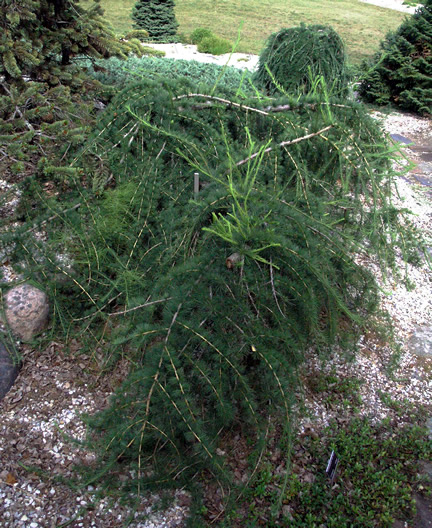
Woody > Larix > Larix decidua > Larix decidua 'Varied Directions'
Larix decidua
'Varied Directions'
Varied Directions European Larch
| Family |
| Pinaceae |
| Genus |
| Larix |
| Species |
| decidua |
| Cultivar |
| 'Varied Directions' |
| Category |
| Woody |
| Type |
| Tree (deciduous) |
| Pronunciation |
| USDA Hardiness Zone |
| 3 |
| Height |
| 3 m |
| Spread |
| 3.5 m |
Photographs
Description and Growing Information
Flowering Period
| General Description |
| A unique plant developed by Dr. Sid Waxman of the University of Connecticut, this cultivar forms a weeping, spreading plant with main branches that radiate out in an irregular pattern (hence the name). The ultimate form of this plant seems to depend |
| Landscape |
| Used as a screen, specimen, and park tree. |
| Cultivation |
| Easily transplanted when dormant. Well-drained, slightly acidic to neutral soil is best, but can tolerate poorily-drained soils. Requires full sun; tolerant of air polution and wind. |
| Growth |
| Medium |
| ID Characteristic |
| Robust twigs propel the branches up and out from this vigorous, spreading, deciduous plant. Branches eventually arch down and cover the ground. Fresh green in spring, golden in autumn. Thicker twigs, branches golden-tan, and the spreading habit distinguish this plant from the weeping European larch. |
| Habitat |
| Horticultural origin. |
| Bark/Stem Description |
| Greyish-brown outer bark. Loose elongated plates reveal a reddish inner bark. Young stems are yellowish and furrowed. |
| Leaf Description |
| Soft, flat needles, 25-30 mm long. Bright green in spring, turn yellow before dropping, and darkening with maturity. found in groups on spurs or in a spiral arrangement down long branches. |
| Flower Description |
| Flowers are monoecious; both male and female strobili cover tree in early spring. Female flowers are egg-shaped and about 0.5-2 cm long, in reds, pinks, yellows, or green. Male flowers are smaller and yellow. |
| Fruit Description |
| Cones are ovoid, 2.5-4 cm long, and persistent. Purple cones dry to brown; young cones somewhat showy. Scales pubescent on backside, overlapped, but not reflexed. |
| Notable Specimens |
| The Devonian Botanic Garden, Edmonton, Alberta, Canada. |
| Propagation |
| Propagated from softwood cuttings, semi-hardwood cuttings, and by grafting. |
